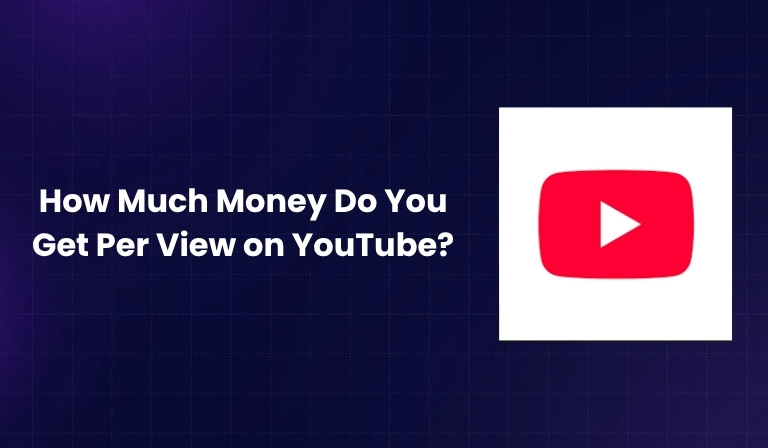YouTube is more than just a video-sharing platform—it’s one of the most powerful tools for creators to earn money online. In 2025, more people are turning to YouTube as a side hustle or even a full-time career. But one question remains at the top: How much money do you actually make per view on YouTube?
This blog will break down the numbers, explain what affects your earnings, and give you real tips to help you earn more as a creator.
How Do YouTubers Make Money Per View?
Not every view on YouTube earns money. YouTubers earn from monetized views, which usually include ads. To get paid per view, a few things need to happen:
- The viewer must see or interact with an ad.
- The video must follow YouTube’s monetization policies.
- The creator must be enrolled in the YouTube Partner Program (YPP).
Key Terms:
- CPM (Cost Per Mille): How much advertisers pay per 1,000 ad views.
- RPM (Revenue Per Mille): How much a creator earns per 1,000 views after YouTube takes its cut.
YouTube Pay Per View Rates in 2025: A Detailed Breakdown
On average, creators earn between $2 to $12 per 1,000 views. However, this can vary widely based on niche, audience, and location.
Estimated YouTube Ad Revenue (2025):
| Views | Estimated Earnings |
| 1,000 views | $2 – $12 |
| 100,000 views | $120 – $800 |
| 1,000,000 views | $1,200 – $6,000 |
These numbers reflect ad-based revenue only. With sponsorships, merch, and affiliate marketing, the earnings can be much higher.
What Factors Affect Your Earnings Per View on YouTube?
YouTube doesn’t pay a fixed rate per view. Several things impact how much money you make:
1. Niche and Content Type
Finance, tech, and education often have higher CPMs, while vlogs and entertainment typically have lower ones.
2. Audience Location
Advertisers pay more for viewers in the U.S., Canada, U.K., and Australia.
3. Viewer Engagement and Watch Time
Videos with higher engagement (likes, comments, long watch times) are shown more and may earn better ads.
4. Ad Types and Placement
Skippable, non-skippable, bumper ads, and mid-roll ads all pay differently.
5. Device Used
Desktop views often pay more than mobile because more premium ads are shown.
How To Get Paid Per View: YouTube Partner Program Explained
To earn per view from ads, you must join the YouTube Partner Program (YPP). As of 2025, the basic requirements include:
- 500 subscribers
- 3 valid public uploads in the last 90 days
- Either 3,000 public watch hours in the last 12 months OR 3 million Shorts views in the last 90 days
Monetization Tools in YPP:
- Ad Revenue (via AdSense)
- YouTube Premium Revenue
- Channel Memberships
- Super Chat & Super Thanks
- Merch Shelf
YouTube pays creators monthly through AdSense, typically between the 21st–26th of each month, as long as the earnings exceed the $100 threshold.
Also Check: How To Make Money On TikTok In 2025: 11 Effective Strategies
How Much Money Can You Make From YouTube Shorts Per View?
In 2025, YouTube continues to monetize Shorts using an ad revenue sharing model.
Shorts Monetization Overview:
- Ads are shown between Shorts on the feed.
- Revenue from these ads is split between all eligible creators.
- On average, creators can earn $0.02 – $0.06 per 1,000 views on Shorts.
While this seems low, Shorts tend to go viral quickly, so total earnings can still add up with volume.
How Much Do YouTubers Actually Make Monthly or Yearly?
Let’s look at realistic examples of monthly and yearly income:
Small Creator (10,000 subscribers):
- Monthly views: 50,000
- Earnings: ~$100–$300/month
Mid-Level Creator (100,000 subscribers):
- Monthly views: 500,000
- Earnings: ~$1,200–$3,000/month
Full-Time Creator (500,000+ subscribers):
- Monthly views: 2–5 million
- Earnings: ~$6,000–$20,000/month (excluding brand deals)
Creators often earn even more through sponsorships, products, and affiliate links.
3 Expert Tips to Maximize Your Earnings Per View
1. Pick a High-CPM Niche
If you’re starting out, consider niches like finance, tech, education, real estate, or B2B topics. These often attract higher-paying advertisers.
2. Use Mid-Roll and End-Roll Ads Wisely
For videos over 8 minutes, you can insert mid-roll ads. Strategically place them after a cliffhanger or between content sections to reduce viewer drop-off.
3. Optimize for Engagement
Create compelling intros, use on-screen text, and encourage likes/comments to increase viewer retention and video reach.
Bonus: 5 Alternative Ways to Earn Money Beyond Ads
Don’t rely only on ad revenue. These income streams can significantly boost your YouTube income:
- Sponsorships: Partner with brands for paid shoutouts or product placements.
- Affiliate Marketing: Promote products and earn a commission per sale.
- Merchandise Sales: Sell your own branded gear through platforms like Teespring or Shopify.
- Channel Memberships: Offer exclusive perks to paying subscribers.
- Patreon: Give fans behind-the-scenes content in exchange for monthly support.
FAQs
1. What is AdSense and how does it work with YouTube?
AdSense is the tool that pays you for your YouTube ad revenue. YouTube places ads on your videos, and AdSense processes and pays your earnings.
2. Do you get paid for every view?
No. You only get paid for monetized views, usually when a viewer sees or interacts with an ad.
3. How are earnings calculated for YouTube Premium views?
If a Premium user watches your video, YouTube shares a portion of the subscriber’s fee with you, based on watch time.
4. How can I boost watch time and subscribers?
Post consistently, use engaging titles and thumbnails, and focus on audience retention.
5. When does YouTube send payments to creators?
YouTube pays creators between the 21st–26th of each month, as long as your AdSense balance is $100 or more.
Conclusion
YouTube doesn’t offer a fixed rate per view, but with the right strategy, niche, and effort, it can become a serious income source. Whether you’re creating Shorts or long-form videos, understanding how YouTube pays you per view is the first step to success.
Want to earn more? Focus on high-CPM topics, boost engagement, and diversify your revenue. With consistency and creativity, your YouTube channel can pay off—literally.

